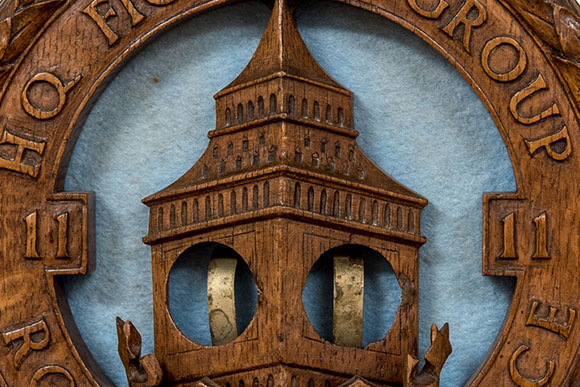C1940
Dimensions: 35cm high
Material: Wood
To listen to the audio description of this object either click the object audio MP3 file below which will play it in your default audio player, or press the play button which you will find after the object audio MP3 file and this will play it from within the web page. The play button can also be used to pause the audio. This button is followed by the elapsed and remaining time, and a further button to mute the audio.
11 Group Crest Audio MP3 File
The crest for the Headquarters of 11 Group of RAF Fighter Command is about half a metre in height, and made of a dark wood. The main body of the crest is rounded, with a leaf pattern ringing the edge. On the inside of this pattern, written around the circle, are the embossed words ’HQ FIGHTER GROUP ROYAL AIR FORCE’. The number 11 intersects the text halfway on both the left and right sides.
Carved out of the centre is a clock tower on a blue background emerging from a shallow, winged crown. There is another crown on top and below is a curved scroll engraved with the motto, ‘TUTELA CORDIS’, which is Latin for ‘Defence of the Heart’. The clock tower depicted in the crest is the clock tower of the Palace of Westminster, commonly known as ‘Big Ben’.
The Headquarters of 11 Group was based in Uxbridge in Greater London and was commanded by Air Vice-Marshal Sir Keith Park. Fighter Command was organised into four administrative groups, which were responsible for the defence of their geographical area of Britain. 10 Group covered the South West of England and South Wales, 11 Group covered London and the South East, 12 Group covered East Anglia, the Midlands and North Wales, and 13 Group covered the North of England and Scotland. Each of these Groups was then subdivided into what was called a “Sector”.
Fighter Command’s organisation of the country during the Second World War into Groups and Sectors aided the communication of vital information about incoming enemy aircraft. This information had to be passed on quickly and accurately, to enable RAF squadrons to be scrambled to intercept enemy raids at the right height and position.
Each Group had their own headquarters and Operations Room. In the Operations Room there was a large tote board which showed the state of readiness of the squadrons within that Group. This helped a Group to decide which sector was best equipped to deal with raids as they appeared on their plotting map. The sectors had direct control of fighter squadrons and contained a principal fighter airfield and sector headquarters with an Operations Room. There were further fighter airfields in each sector, known as satellite airfields.
At the bottom of the crest is a small metal plaque which reads, ‘Presented to the Officers of Headquarters No XI Fighter Group by Squadron Leader E. J. H. Wright MBE 1948’.
 What’s On
What’s On Opening Hours & Admission
Opening Hours & Admission

